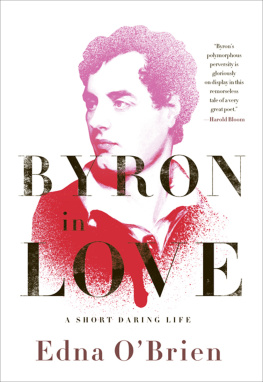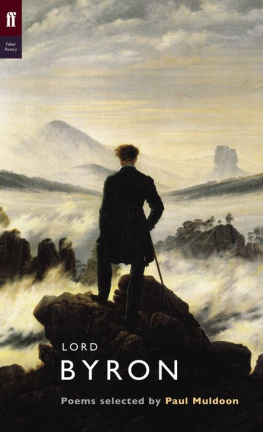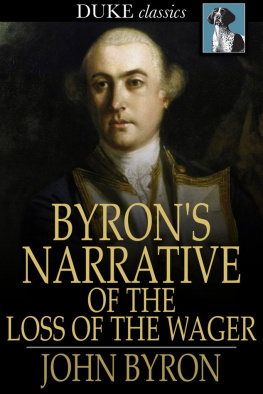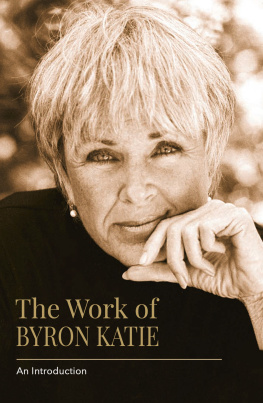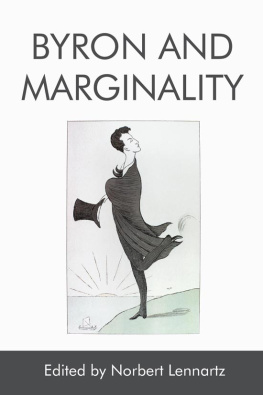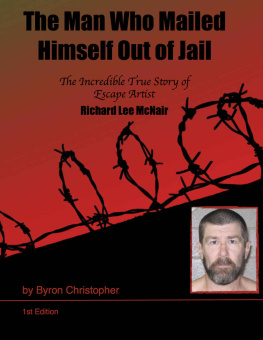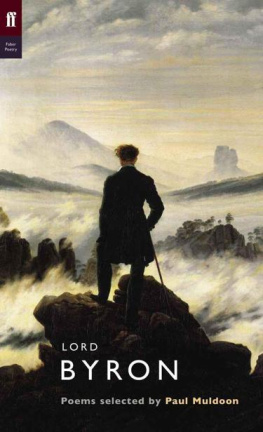BYRON IN LOVE
A Short Daring Life
EDNA OBRIEN

W. W. Norton & Company
New York London
Copyright 2009 by Edna OBrien
All rights reserved
For information about permission to reproduce selections from this book, write to Permissions, W. W. Norton & Company, Inc., 500 Fifth Avenue, New York, NY 10110
Library of Congress Cataloging-in-Publication Data
OBrien, Edna.
Byron in love: a short daring life / Edna OBrien.1st American ed.
p.cm.
ISBN: 978-0-393-07127-6
1. Byron, George Gordon Byron, Baron, 1788-1824. 2. Poets, English19th centuryBiography. I. Title.
PR4381.O47 2009
821'.7dc22
[B] 2009007109
W. W. Norton & Company, Inc.
500 Fifth Avenue, New York, N.Y. 10110
www.wwnorton.com
W. W. Norton & Company Ltd.
Castle House, 75/76 Wells Street, London W1T 3QT
For Ann Getty
a Byron admirer
In the career of writing, a man should calculate upon his powers of resistance before he goes into the arena.
LORD BYRON LETTER TO SHELLEY , 1821
Everything connected with the life and character of so illustrious a bard as the late Lord Byron is public property.
J. MITFORD LES AMOURS SECRETES DE LORD BYRON , 1839
But words are things, and a small drop of ink, Falling like dew upon a thought, produces That which makes thousands, perhaps millions, think.
LORD BYRON DON JUAN III.88
The more Byron is known, the better he will be loved.
TERESA GUICCIOLI, 1873, on her death bed
Contents
ACKNOWLEDGEMENTS
Byron left a great and enduring portrait of himself to posterity, in his Letters and Journals , edited first by R.E. Prothero (1898) and more extensively by Leslie A. Marchand (19734). Professor Marchands three-volume Life of Byron (1957) is essential reading for all Byron aspirants.
I am also deeply grateful to a host of other authorsbiographers, scholars, poets and yes, even scoundrels, who have written with passion, erudition and far-fetchedness, yet the relationship with their subject always fascinating and symbiotic, while being sometimes territorial. They include Tom Moore, R.C. Dallas, John Galt, John Cam Hobhouse, Thomas Medwin, Edward Trelawny, Leigh Hunt, William Parry, Colonel Stanhope, Julius Millingen, Count Pietro Gamba, Teresa Guiccioli, John William Polidori, Samuel Rogers, John Mitford, George Ticknor, John Drinkwater, Ralph Milbanke Lovelace, Andr Maurois, Harriet Beecher Stowe, Ethel Colburn Mayne, Malcolm Elwin, Iris Origo, Thomas Macaulay, Lady Blessington, Harriette Wilson, George Patson, Peter Quennell, Harold Nicolson, Michael Foot, Jerome J. McGann, Doris Langley Moore, Elizabeth Longford, Anne Barton, W. H. Auden, Phyllis Grosskurth, Benita Eisler, Fiona MacCarthy, Megan Boyes, Anne Fleming, Michael and Melissa Bakewell, Kay Redfield Jamison. I also consulted journals and periodicals of the time.
The wonderful staff at the London Library and the British Library were untiring in their help.
INTRODUCTION
In his seminal essay on Shakespeares Antony and Cleopatra , Harold Bloom cites Cleopatra as the archetype of the star and the worlds first celebrity, one who eclipsed her lovers, Pompey, Caesar and Antony, never straying from the empiric necessity of playing herself. Byron must surely rank as her counterpart in life, the first and ongoing celebrity, hero and villain, wooer and narcissist, shackled with a label that has entered everyday currency of being mad, bad and dangerous to know.
It is the same Byron who wrote
What is the end of fame? Tis but to fill
A certain portion of uncertain paper
For this men write, speak, preach, and heroes kill,
And bards burn what they call their midnight taper,
To have, when the original is dust,
A name, a wretched picture and worse bust.
There is a legion of books, treatises, essays and biographies on Lord Byronscholarly, probing, affectionate, discursive, titillating, scurrilous and fantastical, some raising him to an apotheosis and others consigning him to the gutter. Professor Leslie Marchands biography, published in 1957, was Herculean, unearthing much that was hidden and debunking some of the more preposterous claims and fancies.
So why another book on Byron?
Years ago, reading a remark of Lady Blessington that Byron was the most extraordinary and terrifying person [she had] ever met whetted my interest. Writers writing about other artists has always appealed to meRilke on Rodin, addressing that mysterious mediation between the life and the art. Virginia Woolfs Common Reader , providing those quick, deft glimpses that give us the human quotidian and a whiff of the genius within; Hardy watering the ink or Dorothy Wordsworth trudging up a wet road with dear William, to seek out a waterfall.
Similarly with Byron, I wanted to follow him in his Rakes Progress and his Poets Progress, playing billiards in an English country house and passing clandestine notes to a young bride under the very watch of her pontifical husband, Sir Wedderburn Webster, Byron reading Madame de Stals Corinne in the garden of his Italian mistress and writing her a love letter in English, which neither she nor her jealous husband would understand. Byron in love, Byron seized with melancholia and Byron in intermittent phrenzy with his forbearing publisher John Murray. Byron who mapped for himself a great and tragic destiny, going as he thought to the seat of war, when he set out to join in the cause for Greek independence, and instead dying of a fever in a swamp in Missolonghi at the age of thirty-six, the face that had been the Adonis of all Europe covered in leeches and bandages.
So I immersed myself in the twelve volumes of his letters and journals, in which he variously reveals himself as a passionate man, an intellectual man, a wounded man, a jesting man and the archetype for Napoleon, Don Quixote, Don Juan, Richard Lovelace, Richard III, Richard II and ultimately a Lear surrounded by knaves and fools. I read the numerous biographies of him and those of Lady Byron, the histrionic accounts of a marriage of just over one year, that not only served as fascination for the tabloids and cartoonists of his time, but even intrigued such an elevated mind as Goethes.
Byron with his odes and his dithyrambics, his scoffing at litteratoor , coupled with his lifelong service to it, his banter and colloquy with men and women, his excruciating dissection of his own delinquencies, proved to be a very great and unnerving companion.
ONE
Lord George Gordon Byron was five feet eight and a half inches in height, had a malformed right foot, chestnut hair, a haunting pallor, temples of alabaster, teeth like pearls, grey eyes fringed with dark lashes and an enchantedness that neither men nor women could resist. Everything about him was a paradox, insider and outsider, beautiful and deformed, serious and facetious, profligate but on occasion miserly, and possessed of a fierce intelligence trapped however in a childs magic and malices. What he wrote concerning the poet Robert Burns could easily serve as his own epitaphtenderness, roughnessdelicacy, coarsenesssentiment, sensualitydirt and deityall mixed up in that one compound of inspired clay.
He was also a gigantic poet, but as he reminds us, poetry is a distinct faculty and has no more to do with the individual than has the pythoness when she is off her tripod. Byron, off his tripod, becomes Byron the Man, who by his own admission could not exist without some object of love. His passions were developed very early and generated excitement, melancholy and foreboding at the loss that was bound to occur in the terrestrial paradise. He loved men and women, needing the other, whoever she or he might be. He had only to look at a beautiful face and was ready to build and burn another Troy.

